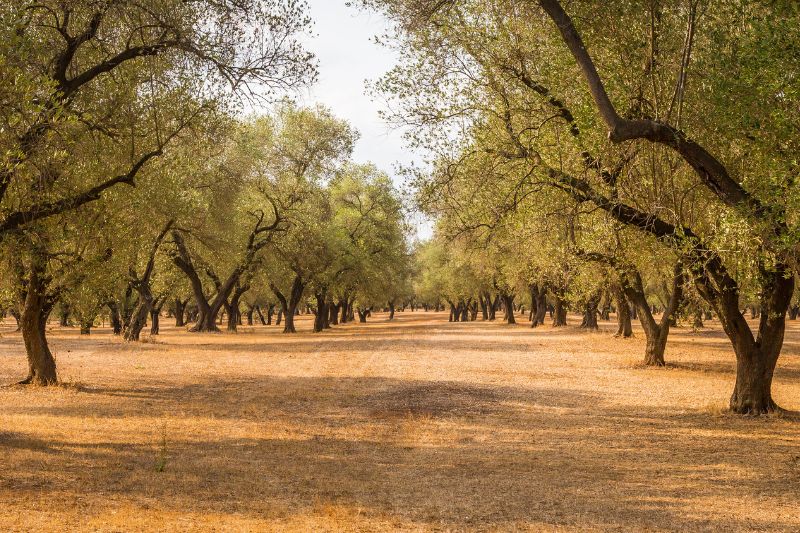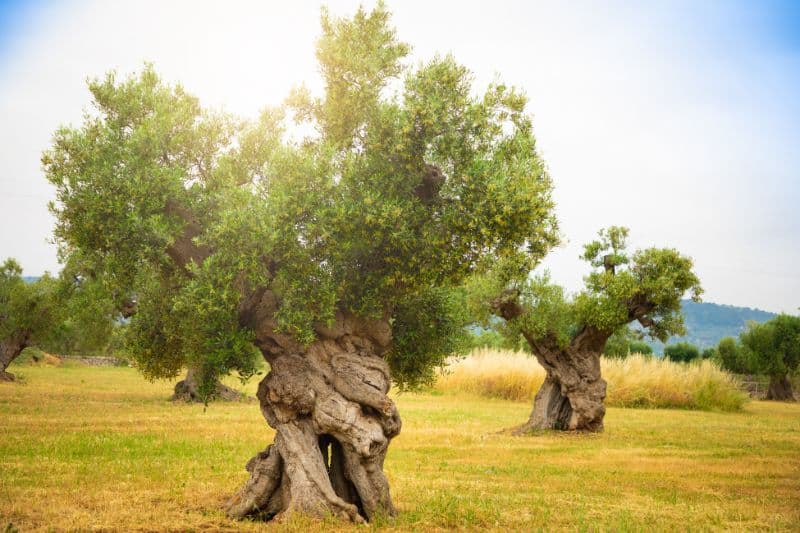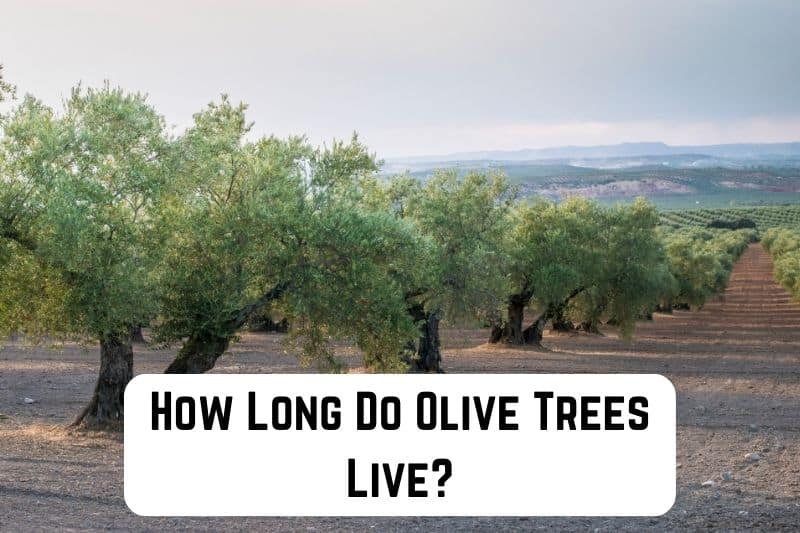Olive trees are a popular choice for people who want to bring some Mediterranean flair to their garden. These attractive trees have leathery, lance-shaped green leaves that are silver underneath. They’re also rich in history, dating back to the Early Bronze Age and being associated with Ancient Greece. If you want to plant an olive tree in your garden, you might wonder, how long do olive trees live?
Olive trees can live for many centuries, with most varieties living up to 500 years! However, some of the oldest olive trees are still alive and can live for thousands of years.
Read: Do Pine Trees Have Deep Roots?
How Long Do Olive Trees Live?
Olive trees live for hundreds, if not thousands, of years. They can withstand climate change, the death and rebirth of civilizations in their region, and heavy storms. Currently, in Greece, the oldest olive tree in the world is more than 2,000 years and still going strong – it even produces fruit!
Olive trees have a long lifespan because they are hardy, resilient trees that can withstand extreme temperatures and conditions, such as drought. They also tend to grow slowly, so they pace their growth over many years.
Why Do Olive Trees Live So Long?
Olive trees live so long because they have a very slow-paced growth. They can take multiple years to reach a mature size. They also have regeneration abilities that enable them to tolerate difficult conditions.
Olive trees have strong root systems that regenerate, even if there’s a cold frost or fire that destroys the above-ground parts of the tree and surrounding vegetation. The tree’s buds go dormant and can spring forth into new life despite the toughest conditions.
Another factor that contributes to an olive tree’s long lifespan is that its root system stretches out so that it can find water or nutrients further away from where the tree has been planted. This helps the tree to survive during drought and desert-like conditions.
Do Olive Trees Lose Their Leaves Every Year?
Olive trees lose their leaves every year, but this happens gradually. When an olive tree is two or three years old, its leaves turn yellow during spring and then fall off when new leaves start to grow on the tree. This is natural behavior of the olive tree, as it sheds old or dying leaves to make space for new growth.

- Under- or overwatered. If you’re giving your tree too little or too much water, this can cause it to become stressed, which can result in its leaves falling off. Ensure the soil in which you’ve planted the tree is well-draining so that it doesn’t sit in soggy soil.
- Exposed to extremely hot conditions. If your olive tree is exposed to temperatures higher than 95° F (35° C) for a long time, this can cause its growth to suffer. You might notice that the tree struggles to grow new leaves and olives.
- Not planted in enough sunlight. Olive trees are suited for a Mediterranean climate, so you should ensure that they get a minimum of six hours of sunshine per day. If the olive tree doesn’t get enough light, it will have less growth and experience droopy or fallen leaves.
What is the Oldest Olive Tree in the World?
The oldest olive tree in the world is between 2,000 and 4,000 years old. It’s found in a town called Ano Vouves in Crete, Greece, and is said to be the oldest monumental olive tree in the world. It’s a protected natural monument.
This tree still produces olives and a strong-tasting oil. The tree’s trunk has a 41-foot (12.5m) perimeter and 15.4-foot (4.5m) diameter. The tree has a gnarled appearance. In 2008, cuttings were taken from this olive tree to make wreaths for winners of the 2004 Athens Olympics and 2008 Beijing Olympics.
Lifespan of Olive Trees
Although some olive trees can live for thousands of years, they generally live for hundreds of years. This means you can plant an olive tree that will remain in your family for generations.
Although olive trees can grow and live for hundreds, if not thousands, of years, you must keep them healthy to increase their lifespan. Just because they can withstand extreme conditions, this doesn’t mean that olive trees should be neglected.
For example, although olive trees can withstand frost, you should protect them during the winter if there are extreme conditions. By following some important tips to look after your olive tree, you can keep it alive for a long time.
Although you can grow olive trees in the ground or in a pot, bear in mind that if you want to keep your olive tree in a pot indoors, it will only live for about 10 years.

How do You Take Care of Olive Trees to Maximize the Lifespan?
One of the most important ways to encourage olive trees to thrive and bear fruit is by giving them a dormancy period when it’s cold. Olive trees require a dormancy period of two months when temperatures hit approximately 40° F (4.4° C). They need this colder weather to rest before producing flowers and fruit. But, if you allow the tree to be exposed to temperatures below 20° F (-6.6°C), this can harm or even kill it.
To protect your olive tree in winter, you should consider growing it in a pot. This makes it easier for you to drag it indoors during freezing conditions. If you’re growing your olive tree outside, choose a site that’s sunny and protected from cold and wind.
Here are other tips to follow when caring for your olive trees.
Soil Requirements
Although olive trees can be tolerant of different soil types, they can die if planted in waterlogged soil. This must be avoided, so if your garden is prone to being flooded in certain areas, try to plant your olive tree on a sloped area to encourage excellent water drainage.
Watering Requirements
Water your olive trees that you’ve recently planted twice a week. Established trees that are upwards of five years of age can be watered once every two weeks. These trees are resistant to drought, but if you live in a hot or dry climate, you should increase your watering frequency.
Drip irrigation is a good watering method for your newly-planted olive tree to ensure that it will get enough water during the hot summer months.
Fertilizer Requirements
When you see new growth on the olive tree, such as in the form of flowers, it can benefit from a balanced fertilizer that’s provided throughout its growing season. You can give it monthly feedings during this phase.
Sunlight Requirements
Plant your olive trees in a full-sun area that gets a minimum of six hours of direct light every day. If you’re keeping your olive tree indoors, keep its pot in a south- or west-facing window.
Temperature Requirements
Olive trees want to be planted in an area with a temperature range of between 50° and 85° F (10°-29.4 °C). Although established trees can tolerate a wider range of temperatures, they shouldn’t be exposed to temperatures lower than 15 °F (-9.4 °C) for a long time as this can kill them.
Read: Maple vs Oak Tree: Ways to Differentiate Between Them
Pruning Requirements
Since olive trees grow at a very slow rate, you don’t have to prune them a lot when they’re young. However, if you’re growing an olive tree in a pot, it will grow faster so you should prune it to shape it and allow more light to reach its roots. Remove dead or diseased growth.
Planting Requirements
It’s tricky to grow olive trees from seed, so it’s better to purchase a small olive tree from your local nursery. When you’re ready to plant the tree in the ground, dig a hole that’s the same circumference as the olive tree pot, but check that there’s enough space for the plant’s roots to spread and grow.
When you place the tree and its roots into the hole, backfill the hole with soil. Avoid placing gravel or stones in the hole as this could obstruct, instead of promote, drainage.
You’ll know that your tree has taken root in the ground when you can see that its bark is green in color. If the bark becomes yellow, this indicates that the tree has not taken root. Check the soil for drainage and ensure that the tree is getting enough sunlight.
Growing Olives on the Tree
If you’re growing your olive tree to harvest olives, you should plant it outside in full sun. If you grow it in a pot or container indoors, the tree won’t receive enough light to produce fruit. When growing an olive tree in the ground, it will take a few years of direct sunlight for it to grow fruit.
Generally, it takes olive trees three years to produce fruit. After this time, the tree produces fruit every alternate year. A year of heavy fruit production is usually followed by a lighter-bearing year.






